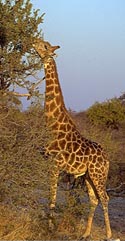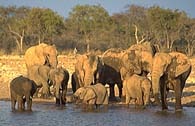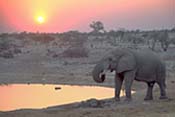|

YBB On Safari in Africa
by Anna Novey, Vanessa Alexander, Matt Ostermann, Patrick Viehover
 Anna- Anna-
From an early age many American children are taken to the zoo. Those seemingly lifeless replicas in their tiny cages are the African animals we know. We also learn about them by watching National Geographic documentaries. As real as they seemed on TV, they easily could have been a figment of some producers imagination.
Vanessa-
Our first destination after picking up the Namibian teens was Etosha National Park. This was the first visit to the park by most of our new Namibian friends also. Etosha was proclaimed as a National Park in 1907. It was the first National Park in Africa and is 8,600 square miles. In the center is the Etosha Pan, a soft shallow clay depression that constitutes over a third of the park. It was once a lake bed, but now hosts many small water holes. They are what allows the park to thrive with antelope, wildebeest, jackals, giraffe, elephants, and the more dangerous leopards, rhinoceros and lions, as well as many other beautiful African animals.
In the park no one is allowed out of their vehicles except in a Rest Camp. This is for the protection of the visitors, the animals and the environment. The rest camps are small, fenced in compounds with a hotel, store, restaurant and campground. Each evening at sunset, the gates close and all visitors are locked safely inside until morning.
When we arrived in the park, we immediately went out on a game drive. Being typical American tourists we were all excited to see our first African animal--any animal.
Anna-
As soon as we went out into the park everyone was glued to the windows of the bus. Tree tops whizzed by as we searched for any sign of an animal. Then we saw it: a long neck and head sticking out above the trees. Before I had time to even realize what we had seen I was screaming "Giraffe, Giraffe." Simultaneously and almost instinctually, we all grabbed our cameras. I started clicking mine, not even bothering to look through the viewfinder, focus it, zoom in, or more importantly, turn the power on.
We saw many beautiful animals including wildebeest, ostrich and the ever present springbok. One of the most elusive animals to be sighted, not only by the common person, but also by researchers is the leopard. It's hard to believe, but true, as I was peering out the window on the long drive across the park, I shouted: "Leopard!" And sure enough, sitting in a tree was a Leopard. It immediately left for cover, but many of us were witness to this master of camouflage.
 Vanessa- Vanessa-
After our first Giraffe sighting we drove to a water hole. A herd of elephants and 3 giraffes were drinking. Seeing these animals in their natural habitat, as opposed to in a zoo or on TV was amazing. We got to witness first hand their natural behaviors.
As natural protection from the sun and bugs, the elephants would throw water and dirt on their backs. This is a habit we had never seen back home. And as icing on the cake, we witnessed a baby elephant accomplish this job by flopping into the dirt and rolling around, amid squeals of elephant play.
We saw many other animals, and no matter how many times we saw another springbok, it was still fascinating to see them in their natural habitat. But unlike at home, they were free to come and go as they pleased while we were the ones who were closed in as if in a cage, for protection.
Patrick-
The rest camps had water holes that protected us from the wild animals, so we could sit outside and watch. One was lit up for viewing at night. This was an opportunity of a lifetime. Here we were able to see the very rare and endangered black rhino as it drank courageously at the water hole.
The king of the Savannah, the lion, often appears at night and many animals are more cautious at the  water holes because of lions. This is the one animal all tourist are hoping most to see. Some tourists have even watched as a springbok became a lion's late night snack. We were not fortunate enough to see one, but enjoyed viewing the night life of Etosha. water holes because of lions. This is the one animal all tourist are hoping most to see. Some tourists have even watched as a springbok became a lion's late night snack. We were not fortunate enough to see one, but enjoyed viewing the night life of Etosha.
Matt-
While in the Park we stayed at the Etosha Educational Center were we got to know the Namibians better, learn about the park and the environmental issues facing Namibia. We also camped at Okakuejo Rest Camp, with the night water hole, hearing the sounds of the wildlife all through the night. The wide variety of animals in their natural habitat were beyond our imagination, even after seeing Wild Kingdom so many times.
|
|
|

![]()
